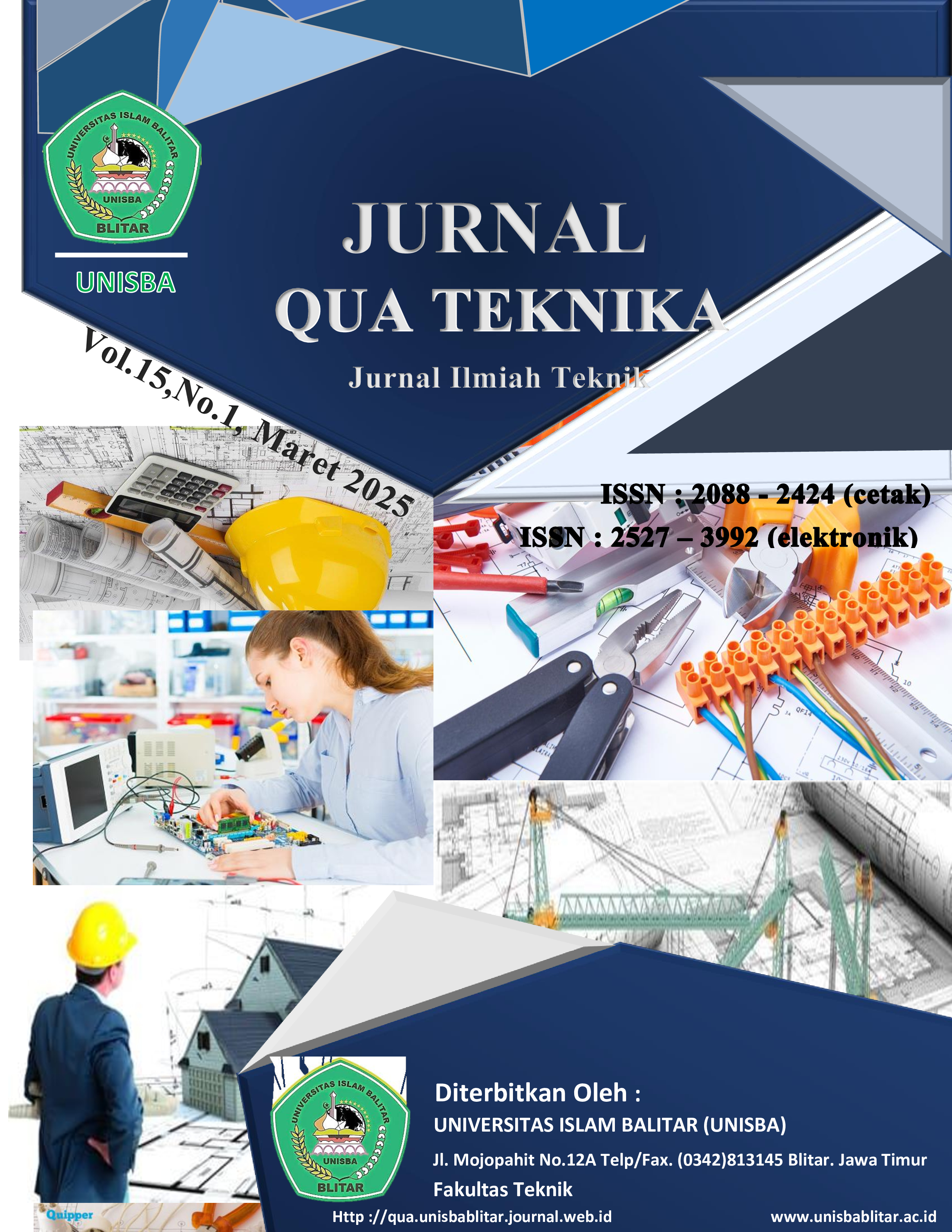ANALISIS PENGARUH TEMPERATUR, SUDUT PV DAN DEBU TERHADAP KINERJA PANEL SURYA 300 WP
ANALISIS PENGARUH TEMPERATUR, SUDUT PV DAN DEBU TERHADAP KINERJA PANEL SURYA 300 WP
Abstract
Abstract: Solar Power Plants (PLTS) have emerged as a promising alternative energy solution amid the increasing demand for electricity and the depletion of fossil resources. However, the efficiency of PLTS remains a major challenge, primarily due to environmental factors such as temperature, panel tilt angle, and dust accumulation. This study aims to analyze the impact of these three factors on the performance of a 300 Wp solar panel. The research method was conducted through experimental testing using a PV tester, with tilt angle variations of 0°, 2°, 4°, and 6°, as well as panel cleanliness conditions with dust additions of 0 grams, 15 grams, and 20 grams. The results indicate that panel temperatures above 45°C reduce efficiency by up to 12%, despite an increase in current. The optimal tilt angle was found at 4°, yielding the highest power output of 119.5 W under clean panel conditions. Dust accumulation of 15 grams reduced power to 117.8 W (5% efficiency loss), while 20 grams of dust significantly decreased power to 105.1 W (12% efficiency loss). This study concludes that temperature control, regular panel cleaning, and proper tilt angle adjustments are crucial steps to enhance the efficiency of solar panels in PLTS systems.
Keywords: PLTS, Solar Panel Efficiency, Temperature, Tilt Angle, Dust.
References
[2] Anoi, Y. H., Yani, A., & Seto, B. A. (2019). Analisis Penyebab dan Perbaikan Vibrasi Pada Fin Fan Blower F1-Ek-9-D1 Milik PT. Badak LNG Bontang. Turbo : Jurnal Program Studi Teknik Mesin, 8(1), 48–55. https://doi.org/10.24127/trb.v8i1.920
[3] Arifin Sinaga, G., Mataram, I. M., & Indra Partha, T. G. (2019). Analisis Pembangkit Listrik Sistem Hybrid Grid Connected Di Villa Peruna Saba, Gianyar – Bali. Jurnal SPEKTRUM, 6(2), 1.
[4] https://doi.org/10.24843/spektrum.2019.v06.i02.p01
[5] Halim, L., Halim, L., & Sudjana, O. (2020). Perancangan Dan Implementasi Awal Solar Inverter Untuk Pembangkit Listrik Tenaga Surya Off Grid. Jurnal Teknologi, 12(1), 31–38.
[6] Hudan, Ivan Safril, R. T. (2019). Rancang Bangun Sistem Monitoring Daya Listrik Pada Kamar Kos Berbasis Internet of Things ( Iot ). Jurnal Teknik ELEKTRO, 08(01), 91–99.
[7] Ima Rochimawati. (2019). Perancangan Pembangkit Listrik Tenaga Surya. Strategy : Jurnal Teknik Industri, 1(1), 169–180. https://doi.org/10.37753/strategy.v1i1.7
[8] Indra Bayu, J., Budi Sulistiyawati, I., & Putu Agustini, N. (2023). Monitoring Pengaruh suhu Pada Panel Surya Terhadap Performa Keluaran Pembangkit Listrik Tenaga Surya. Jurnal FORTECH, 4(1), 27–32. https://doi.org/10.56795/fortech.v4i1.4104
[9] Mohammad Hafidz ;, S. S. (2015). Perancangan Dan Analisis Pembangkit Listrik Tenaga Surya Kapasitas 10 Mw on Grid Di Yogyakarta. Jurusan Teknik Elektro, Sekolah Tinggi Teknik PLN, 7(JURNAL ENERGI & KELISTRIKAN VOL. 7 NO. 1, JANUARI-MEI 2015), 49.
[10] Neli Lestari, N. M., Satya Kumara, I. N., & Dwi Giriantari, I. A. (2021). Review Status Panel Surya Di Indonesia Menuju Realisasi Kapasitas Plts Nasional
[11]
[12] 6500 Mw. Jurnal SPEKTRUM, 8(1), 27.
[13] https://doi.org/10.24843/spektrum.2021.v08.i01.p4
[14] Priajana, P. G. G., Kumara, I. N. S., & Setiawan, I. N. (2020). Grid Tie Inverter Untuk Plts Atap Di Indonesia: Review Standar Dan Inverter Yang Compliance Di Pasar Domestik. Jurnal SPEKTRUM, 7(2), 62.
[15] https://doi.org/10.24843/spektrum.2020.v07.i02.p9
[16] Rakhman Suharso, A., Nugraha, A., & Oktarina Dwi Handayani, D. (2021). Sistem Monitor Dan Kontrol Konsumsi Listrik Rumah Tangga Berbasis Iot Dan Android. Jurnal Rekayasa Teknologi Nusa Putra, 7(2), 1–11. https://doi.org/10.52005/rekayasa.v7i2.51
[17] Sampeallo, A. S., Galla, W. F., & Mbakurawang, F. (2018). Analisis Kinerja Plts 25 Kwp di Gedung Laboratorium Riset Terpadu Lahan Kering Kepulauan Undana terhadap Variasi Beban. Jurnal Media Elektro, 7(1), 13–21.
[18] Samsurizal, Christiono, A. M. (2019). Jurnal Ilmiah Setrum. 8(1), 28–34. Samsurizal, Christiono, & Makkulau, A. (2019). Evaluasi Sudut Kemiringan
[19] Terhadap Pengaruh Irradiance Pada Array Photovoltaic Jenis Monocristalline. Jurnal Ilmiah Setrum, 8(1), 28–34. https://jurnal.untirta.ac.id/index.php/jis/article/view/5135
[20] Suryana, D., & Ali, M. M. (2016). The Effect Of Temperature On Voltage Produced By Monocrystalline Solar Panel (Case Study : Baristand Industri Surabaya). Jurnal Teknologi Proses Dan Inovasi Industri, 2(1), 49–52.
[21] Widodo, S. B., Arif, Z., & Royadi, S. (2015). KAJI EKSPERIMENTAL PENGARUH TEMPERATUR PERMUKAAN PANEL SURYA TERHADAP KELUARAN DAYA.
[22] Yano Hurung Anoi, Ahmad Yani, dan Y. w. (2019). Analisis sudut panel solar cell terhadap daya output dan efisiensi yang dihasilkan. Jurnal SPEKTRUM, 6(3), 107–1
Copyright (c) 2025 Jurnal Qua Teknika

This work is licensed under a Creative Commons Attribution-ShareAlike 4.0 International License.
Authors who publish with this journal agree to the following terms:
- Copyright on any article is retained by the author(s).
- Author grant the journal, right of first publication with the work simultaneously licensed under a Creative Commons Attribution License that allows others to share the work with an acknowledgement of the work’s authorship and initial publication in this journal.
- Authors are able to enter into separate, additional contractual arrangements for the non-exclusive distribution of the journal’s published version of the work (e.g., post it to an institutional repository or publish it in a book), with an acknowledgement of its initial publication in this journal.
- Authors are permitted and encouraged to post their work online (e.g., in institutional repositories or on their website) prior to and during the submission process, as it can lead to productive exchanges, as well as earlier and greater citation of published work.
- The article and any associated published material is distributed under the Creative Commons Attribution-ShareAlike 4.0 International License







